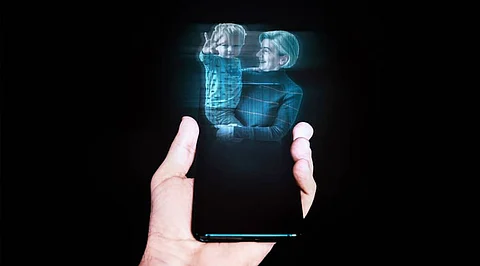

A part of what we see in science fiction movies will soon become a reality, thanks to artificial intelligence. Every time you saw people talking to holograms in sci-fi movies and thought to yourself "that would be awesome to have", you just might be closer to that future. Smartphones will soon be able to create photorealistic 3D holograms with an AI model developed by a research team at MIT. This system determines the best way to generate holograms from a sequence of input images. This fascinating technology could have applications for VR and AR headsets. Unlike conventional 3D and VR displays that create the illusion of depth causing nausea and headaches, a holographic display can be viewed by people without straining their eyes.
A major challenge in creating holographic media is maintaining the data that is needed to create holographs. Every holograph constitutes huge amounts of data which creates the "depth" of the holographs. This is why creating a hologram demands lots of computing power. To simplify this process, researchers at MIT applied deep convolutional neural networks to the problem. This approach created a network that is capable of quickly generating holograms based on pictographic data.
The traditional method of generating holograms creates many chunks of holograms and then uses scientific simulations to combine the chunks into a complete pictorial representation. This process is power-intensive and time-consuming. But according to the IEEE spectrum, the method designed by the team of researchers at MIT is a lot different. It uses deep learning networks to slice images into chunks that can be recompiled into holograms using fewer "slices" than that of the traditional methods. This is possible because of the convolutional neural network's ability to analyze images and separate them into discrete chunks. This new method is far less power-intensive.
In order to design this artificial intelligence holographic generator, the MIT team began by creating a database that included approximately 4000 computer-generated images, with a matchable 3D hologram allotted to each of those images. Based on this dataset, the convolutional neural network was trained to learn the way each of those images was connected to its hologram. When the artificial intelligence system was given the unseen data with depth information, it was able to generate new holograms with the given data. For this process, the depth information is supplied to the AI system through the use of a lidar sensor of multi-camera displays that renders it as a computer-generated image. Some iPhones have these components which makes it possible to generate holograms if connected to the right type of display.
The new artificial intelligence hologram system needs less memory than the traditional methods. This system can create colored 3D holograms at a speed of 60 frames per second with a resolution of 1920 x 1080 using approximately 620 KB of memory, all this by running on a single graphics processing unit (GPU). The MIT research team was able to run their new AI technology on an iPhone 11 creating 1 hologram per second. They also tried it on a Google Edge TPU which could create 2 holograms per second. This implies that the artificial intelligence hologram system can have applications in volumetric 3D printing or in the designing of holographic microscopes.
This is just the inception of this technology. In the future, with further advancements, this technology might revolutionize our way of communication and perceiving visual data. It surely is an exciting time for the tech world.
Join our WhatsApp Channel to get the latest news, exclusives and videos on WhatsApp
_____________
Disclaimer: Analytics Insight does not provide financial advice or guidance. Also note that the cryptocurrencies mentioned/listed on the website could potentially be scams, i.e. designed to induce you to invest financial resources that may be lost forever and not be recoverable once investments are made. You are responsible for conducting your own research (DYOR) before making any investments. Read more here.
